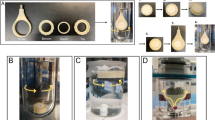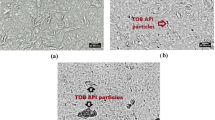Abstract
Ophthalmic ointments are unique in that they combine features of topical drug delivery, the ophthalmic route and ointment (semisolid) formulations. Accordingly, these complex formulations are challenging to develop and evaluate and therefore it is critically important to understand their physicochemical properties as well as their in vitro drug release characteristics. Previous reports on the characterization of ophthalmic ointments are very limited. Although there are FDA guidance documents and USP monographs covering some aspects of semisolid formulations, there are no FDA guidance documents nor any USP monographs for ophthalmic ointments. This review summarizes the physicochemical and in vitro profiling methods that have been previously reported for ophthalmic ointments. Specifically, insight is provided into physicochemical characterization (rheological parameters, drug content and content uniformity, and particle size of the API in the finished ointments) as well as important considerations (membranes, release media, method comparison, release kinetics and discriminatory ability) in in vitro release testing (IVRT) method development for ophthalmic ointments.

Summary of the physicochemcial profiling and in vitro drug release testing (IVRT) for ophthalmic ointments.




Similar content being viewed by others
Abbreviations
- API:
-
Active pharmaceutical ingredient
- CA:
-
Cellulose acetate
- DoE:
-
Design of Experiments
- FDC:
-
Franz diffusion cell
- FTIR:
-
Fourier-transform infrared
- G’:
-
Storage modulus
- G”:
-
Loss modulus
- IVRT:
-
In vitro release testing
- MCE:
-
Mixed cellulose ester
- PES:
-
Polyethersulfone
- PDMS:
-
Polydimethylsiloxane
- PLM:
-
Polarized light microscopy
- PTFE:
-
Polytetrafluoroethylene
- PVDF:
-
Polyvinylidene fluoride
- PXRD:
-
Powder X-ray Diffraction
- Q1/Q2 equivalent:
-
Qualitative and quantitative sameness
- RLD:
-
Reference listed drug
- SDS:
-
Sodium dodecyl sulfate
- USP:
-
US pharmacopeia
- VDC:
-
Vertical diffusion cell
References
Järvinen K, Järvinen T, Urtti A. Ocular absorption following topical delivery. Adv Drug Deliv Rev. 1995;16:3–19.
Pal Kaur I, Kanwar M. Ocular preparations: the formulation approach. Drug Dev Ind Pharm. 2002;28:473–93.
Greaves J, Wilson C, Birmingham A. Assessment of the precorneal residence of an ophthalmic ointment in healthy subjects. Br J Clin Pharmacol. 1993;35:188.
FDA Orange Book. Url: https://www.accessdata.fda.gov/scripts/cder/ob/ (accessed: 08.12.18).
Ueda CT, Shah VP, Derdzinski K, Ewing G, Flynn G, Maibach H, Marques M, Rytting H, Shaw S, Thakker K. Topical and transdermal drug products, Pharmacopeial Forum. 2009; pp 750–764.
FDA U. Guidance for industry. Nonsterile semisolid dosage forms, scale-up and postapproval changes: chemistry, manufacturing, and controls; in vitro release testing and in vivo bioequivalence documentation. Center for Drug Evaluation and Research (CDER). 1997.
Aldrich DS, Bach CM, Brown W, Chambers W, Fleitman J, Hunt D, et al. Ophthalmic preparations. US Pharmacopeia. 2013;39:1–21.
Xu X, Al-Ghabeish M, Rahman Z, Krishnaiah YS, Yerlikaya F, Yang Y, et al. Formulation and process factors influencing product quality and in vitro performance of ophthalmic ointments. Int J Pharm. 2015;493:412–25.
Bao Q, Jog R, Shen J, Newman B, Wang Y, Choi S, et al. Physicochemical attributes and dissolution testing of ophthalmic ointments. Int J Pharm. 2017;523:310–9.
Dong Y, Qu H, Pavurala N, Wang J, Sekar V, Martinez MN, et al. Formulation characteristics and in vitro release testing of cyclosporine ophthalmic ointments. Int J Pharm. 2018;544:254–64.
Bhagurkar AM, Angamuthu M, Patil H, Tiwari RV, Maurya A, Hashemnejad SM, et al. Development of an ointment formulation using hot-melt extrusion technology. AAPS PharmSciTech. 2016;17:158–66.
Bao Q, Shen J, Jog R, Zhang C, Newman B, Wang Y, et al. In vitro release testing method development for ophthalmic ointments. Int J Pharm. 2017;526:145–56.
Rege PR, Vilivalam VD, Collins CC. Development in release testing of topical dosage forms: use of the enhancer cell™ with automated sampling. J Pharm Biomed Anal. 1998;17:1225–33.
El Gendy AM, Jun H, Kassem AA. In vitro release studies of flurbiprofen from different topical formulations. Drug Dev Ind Pharm. 2002;28:823–31.
Reichling J, Landvatter U, Wagner H, Kostka K-H, Schaefer UF. In vitro studies on release and human skin permeation of Australian tea tree oil (TTO) from topical formulations. Eur J Pharm Biopharm. 2006;64:222–8.
Shekunov BY, Chattopadhyay P, Tong HH, Chow AH. Particle size analysis in pharmaceutics: principles, methods and applications. Pharm Res. 2007;24:203–27.
Ali Y, Lehmussaari K. Industrial perspective in ocular drug delivery. Adv Drug Deliv Rev. 2006;58:1258–68.
Bao Q, Burgess DJ. unpublished data. 2018.
Yamamoto Y, Fukami T, Koide T, Suzuki T, Hiyama Y, Tomono K. Pharmaceutical evaluation of steroidal ointments by ATR-IR chemical imaging: distribution of active and inactive pharmaceutical ingredients. Int J Pharm. 2012;426:54–60.
Konning G, Mital H. Sheabutter V: effect of particle size on release of medicament from ointment. J Pharm Sci. 1978;67:374–6.
Pandey P, Ewing GD. Rheological characterization of petrolatum using a controlled stress rheometer. Drug Dev Ind Pharm. 2008;34:157–63.
Barry B, Grace A. Rheological properties of white soft paraffin. Rheol Acta. 1971;10:113–20.
Park E-K, Song K-W. Rheological evaluation of petroleum jelly as a base material in ointment and cream formulations with respect to rubbing onto the human body. Korea-Australia Rheol J. 2010;22:279–89.
Barry B, Grace A. Structural, rheological and textural properties of soft paraffins. J Texture Stud. 1971;2:259–79.
Muynck C, Lalljie S, Sandra P, Rudder D, Aerde P, Remon JP. Chemical and physicochemical characterization of petrolatums used in eye ointment formulations. J Pharm Pharmacol. 1993;45:500–3.
Faust HR, Casserly EW. Petrolatum and regulatory requirements, Penreco. NPRA International Lubricants & Waxes Meeting, November. Citeseer. 2003; pp. 13–14.
Ahmed TA, Ibrahim HM, Ibrahim F, Samy AM, Fetoh E, Nutan MT. In vitro release, rheological, and stability studies of mefenamic acid coprecipitates in topical formulations. Pharm Dev Technol. 2011;16:497–510.
Krishnaiah YS, Xu X, Rahman Z, Yang Y, Katragadda U, Lionberger R, et al. Development of performance matrix for generic product equivalence of acyclovir topical creams. Int J Pharm. 2014;475:110–22.
Bao Q, Newman B, Wang Y, Choi S, Burgess D. In vitro and ex vivo correlation of drug release from ophthalmic ointments. J Controlled Release: Off J Controlled Release Soc. 2018;276:93–101.
Shah VP, Elkins J, Hanus J, Noorizadeh C, Skelly JP. In vitro release of hydrocortisone from topical preparations and automated procedure. Pharm Res. 1991;8:55–9.
Saitoh I, Takagishi Y. Effect of temperature on bleeding and drug release from a liquid droplet dispersion ointment. Biol Pharm Bull. 1995;18:326–9.
Shah VP, Elkins JS. In-vitro release from corticosteroid ointments. J Pharm Sci. 1995;84:1139–40.
Mura P, Nassini C, Proietti D, Manderioli A, Corti P. Influence of vehicle composition variations on the in vitro and ex vivo clonazepam diffusion from hydrophilic ointment bases. Pharm Acta Helv. 1996;71:147–54.
Zatz JL, Varsano J, Shah VP. In vitro release of betamethasone dipropionate from petrolatum-based ointments. Pharm Dev Technol. 1996;1:293–8.
Flynn GL, Shah VP, Tenjarla SN, Corbo M, DeMagistris D, Feldman TG, et al. Assessment of value and applications of in vitro testing of topical dermatological drug products. Pharm Res. 1999;16:1325–30.
Müller-Goymann C, Alberg U. Modified water containing hydrophilic ointment with suspended hydrocortisone-21-acetate–the influence of the microstructure of the cream on the in vitro drug release and in vitro percutaneous penetration. Eur J Pharm Biopharm. 1999;47:139–43.
Nallagundla S, Patnala S, Kanfer I. Comparison of in vitro release rates of acyclovir from cream formulations using vertical diffusion cells. AAPS PharmSciTech. 2014;15:994–9.
Tiffner KI, Kanfer I, Augustin T, Raml R, Raney SG, Sinner F. A comprehensive approach to qualify and validate the essential parameters of an in vitro release test (IVRT) method for acyclovir cream, 5%. Int J Pharm. 2018;535:217–27.
Ayres JW, Laskar PA. Diffusion of benzocaine from ointment bases. J Pharm Sci. 1974;63:1402–6.
Bottari F, Di Colo G, Nannipieri E, Saettone M, Serafini M. Influence of drug concentration on in vitro release of salicylic acid from ointment bases. J Pharm Sci. 1974;63:1779–83.
Chowhan Z, Pritchard R. Release of corticoids from oleaginous ointment bases containing drug in suspension. J Pharm Sci. 1975;64:754–9.
Bottari F, Di Colo G, Nannipieri E, Saettone M, Serafini M. Release of drugs from ointment bases II: in vitro release of benzocaine from suspension-type aqueous gels. J Pharm Sci. 1977;66:926–31.
Behme RJ, Kensler TT, Brooke D. A new technique for determining in vitro release rates of drugs from creams. J Pharm Sci. 1982;71:1303–5.
Takamura A, Ishii F, Noro SI, Koishi M. Physicopharmaceutical characteristics of an oil-in-water emulsion-type ointment containing diclofenac sodium. J Pharm Sci. 1984;73:676–81.
Ong JT, Manoukian E. Release of lonapalene from two-phase emulsion-type ointment systems. Pharm Res. 1988;5:16–20.
Velissaratou A, Papaioannou G. In vitro release of chlorpheniramine maleate from ointment bases. Int J Pharm. 1989;52:83–6.
Kumar P, Sanghvi P, Collins CC. Comparison of diffusion studies of hydrocortisone between the Franz cell and the enhancer cell. Drug Dev Ind Pharm. 1993;19:1573–85.
Collins CC, Little AC, Sanghvi PP, Hofer H, Swon JE. Transdermal cell test matter volume-adjustment device. Google Patents 1995.
Petró É, Paál T, Erős I, Kenneth A, Baki G, Csóka I. Drug release from semisolid dosage forms: a comparison of two testing methods. Pharm Dev Technol. 2015;20:330–6.
Chattaraj S, Kanfer I. ‘The insertion cell’: a novel approach to monitor drug release from semi-solid dosage forms. Int J Pharm. 1996;133:59–63.
Chattaraj S, Swarbrick J, Kanfer I. A simple diffusion cell to monitor drug release from semi-solid dosage forms. Int J Pharm. 1995;120:119–24.
Chattaraj S, Kanfer I. Release of acyclovir from semi-solid dosage forms: a semi-automated procedure using a simple plexiglass flow-through cell. Int J Pharm. 1995;125:215–22.
Olejnik A, Goscianska J, Nowak I. Active compounds release from semisolid dosage forms. J Pharm Sci. 2012;101:4032–45.
Naik P, Shah SM, Heaney J, Hanson R, Nagarsenker MS. Influence of test parameters on release rate of hydrocortisone from cream: study using vertical diffusion cell. Dissolut Technol. 2016;23:14–20.
Kregar ML, Dürrigl M, Rožman A, Jelčić Ž, Cetina-Čižmek B, Filipović-Grčić J. Development and validation of an in vitro release method for topical particulate delivery systems. Int J Pharm. 2015;485:202–14.
Sesto Cabral ME, Ramos AN, Cabrera CA, Valdez JC, González SN. Equipment and method for in vitro release measurements on topical dosage forms. Pharm Dev Technol. 2015;20:619–25.
Marques MR, Loebenberg R, Almukainzi M. Simulated biological fluids with possible application in dissolution testing. Dissolution Technol. 2011;18:15–28.
Higuchi T. Rate of release of medicaments from ointment bases containing drugs in suspension. J Pharm Sci. 1961;50:874–5.
Shah VP, Elkins JS, Williams RL. Evaluation of the test system used for in vitro release of drugs for topical dermatological drug products. Pharm Dev Technol. 1999;4:377–85.
Siepmann J, Peppas NA. Higuchi equation: derivation, applications, use and misuse. Int J Pharm. 2011;418:6–12.
Xu X, Al-Ghabeish M, Krishnaiah YS, Rahman Z, Khan MA. Kinetics of drug release from ointments: role of transient-boundary layer. Int J Pharm. 2015;494:31–9.
Acknowledgements and Disclosures
Funding for this project was made possible by a Food and Drug Administration grant (1U01FD005177–01). The views expressed in this review do not reflect the official policies of the U.S. Food and Drug Administration or the U.S. Department of Health and Human Services; nor does any mention of trade names, commercial practices, or organization imply endorsement by the United States Government. Dissolution equipment support from Sotax Corporation is highly appreciated. The authors are grateful to Dr. Louis Tisinger (application specialist, Agilent Technologies) and Mr. Keegan A. McHose (product specialist, Agilent Technologies) for FTIR-imaging test support.
Author information
Authors and Affiliations
Corresponding author
Additional information
Guest Editors: Hovhannes J Gukasyan, Shumet Hailu, and Thomas Karami
Rights and permissions
About this article
Cite this article
Bao, Q., Burgess, D.J. Perspectives on Physicochemical and In Vitro Profiling of Ophthalmic Ointments. Pharm Res 35, 234 (2018). https://doi.org/10.1007/s11095-018-2513-3
Received:
Accepted:
Published:
DOI: https://doi.org/10.1007/s11095-018-2513-3




